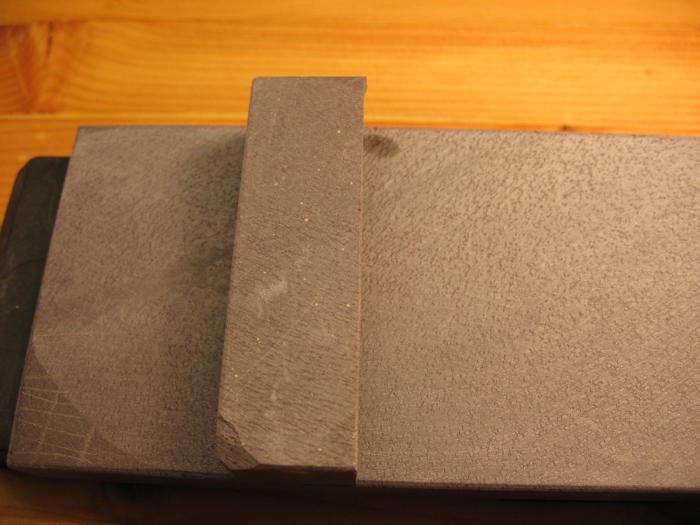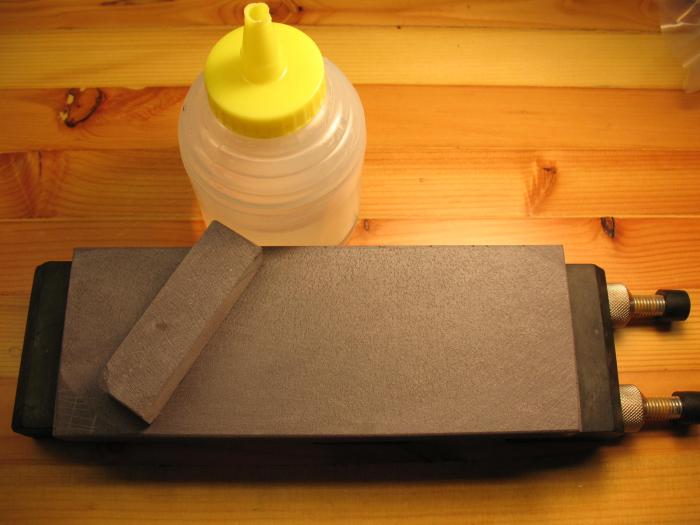Results 21 to 30 of 42
Thread: Stone Identification
-
03-02-2009, 04:08 AM #21

Not sure what year they started with slate. If you put some water on it and hit it with the 325 paper and the slurry is sort of purple it may be a blue. If it is slate it will be a dirty gray.
Be careful how you treat people on your way up, you may meet them again on your way back down.
-
03-02-2009, 04:15 AM #22

Looks like there is a bucket load of garnet in that stone, look at all the red. Nice stone!
It is easier to fool people than to convince them they have been fooled. Twain
-
03-02-2009, 04:43 AM #23

The backside of that stone, aside from the color of the stone in the picture has BBW written all over it for me. I agree, if you lap that back you should know if you see purple slurry; unless it's a weird anomaly and it's a black BBW or some such thing. It could be my imagination, but I see this in the backside of your stone:


Chris L"Blues fallin' down like hail." Robert Johnson
"Aw, Pretty Boy, can't you show me nuthin but surrender?" Patti Smith
-
03-02-2009, 06:23 AM #24Hones & Honing




- Join Date
- May 2005
- Location
- Saint Paul, Minnesota, United States
- Posts
- 8,023
- Blog Entries
- 1
Thanked: 2209
The light colored side is a Belgian Coticule, about 10,000 grit, and the dark side is a Belgian BBW, about 4000-6000 grit. Both are natural stones and very good for razors. Laps each side to a 1000 grit finish and start reading threads posted by Bart in the honing section.
Nice catch!, Randolph Tuttle, a SRP Mentor for residents of Minnesota & western Wisconsin
Randolph Tuttle, a SRP Mentor for residents of Minnesota & western Wisconsin
-
03-02-2009, 08:26 AM #25Member

- Join Date
- Nov 2008
- Location
- Denmark
- Posts
- 86
Thanked: 7
To me it looks like a pink coticule ..
-
03-02-2009, 02:38 PM #26

Thanks everyone for all the help. I talked more to my mother about the stone and she thinks my dad brought it with him when they migrated to the states in 1960. So if that's the case it came from Northern France. I do know for sure it is older than me I am 28. It does look to have some red in it as well as some yellow. What is the grit difference on the pink stone and the yellow? Well once again thanks everyone.

-
03-02-2009, 06:46 PM #27Coticule researcher

- Join Date
- Jan 2008
- Location
- Belgium
- Posts
- 1,872
Thanked: 1212
Coticules cannot be given a grit rating like one would do with other hones. That is because they work quite different than the majority of hones that abrade steel by means of small particles that scratch the steel away. Not Coticules. Mother Nature has loaded this exceptional rock with "garnets". Garnets are a kind of very hard crystals that are roughly round in a faceted way. They vary in size between 5 and 15 micron (in Coticules) and they abrade the steel in a very slow and gentle way. They do leave a scratch pattern, but it is very shallow and wavy. If you release the garnets from the stone and mix them with water, we call it "slurry". It is done by putting water on the hone and rubbing with another piece of Coticule till a milk-like substance has formed. In the slurry, the garnets are free to spin underneath the steel while honing, and this speeds up the proces tremendously. Many Cotilules have a cutting speed compareble to a 1K synthetic hone, when used with slurry. It has been reported that Coticules with pinkish shades are often among the fastest Coticules, but you never know until you try. With a fast stone, the slurry will start to show grayish discoloration almost immediately, from steel entering the mixture.
In slurry mode, such a Cotiule is a superb hone for bevel setting and correction. The resulting bevel doesn't carry deep scratches and is ready for refinement on hones that can push the keenness a bit further. Coticules with slurry will prevent the edge from becoming sharper than a certain level. It is extremely sharp for a knife, but for shaving there still is some pulling sensation at that keeness level. At the same time, this behavior also prevents overhoning.
When used with water only (no slurry) Coticules are among the best finishing hones, but in that mode they offer hardly any keenness improvement. Their benefits lie into smoothing already keen edges. The resulting edges are nice to the skin and seem to discern very well between severing whiskers and catching skin. (decent shaving technique remains important though ).
).
I have made a basic article in the Wiki about honing with a Coticule. It starts off at a DMT1200, but if your Coticule is up to it, you can easily replace the DMT by your Coticule with slurry. The article is here: A simple honing method with DMT-E , Belgian Blue Whetstone and Coticule - Straight Razor Place Wiki
Bart.Last edited by Bart; 03-02-2009 at 11:46 PM.
-
-
03-02-2009, 08:03 PM #28

Hey Bart, thanks for the great article! I think that what
you have described is a pretty neat approach to honing.
- Scott
-
03-02-2009, 09:54 PM #29

A small side-step full of 'mays' and 'coulds' you could or may not find interesting:
As you wrote your father came from the North of France, and conjecturing your nick bar the first letter is your surname - a Dutch name, meaning 'brewer('s son)' - I assume he may have been from Flemish France, in the present Région Nord-Pas de Calais. One of the most respected cutlers in this region were, and still are Maison Leclerq of Boulogne-sur-Mer, purveyors of fine knives, scissors and razors and all related since 1807. First misreading the stamps for Lecler Co, Bouloon Manah recently sold this razor made for them in consignment. Your hone could well have been purchased at this same House.
-
The Following User Says Thank You to Oldengaerde For This Useful Post:
hi_bud_gl (03-03-2009)
-
03-02-2009, 10:28 PM #30Coticule researcher

- Join Date
- Jan 2008
- Location
- Belgium
- Posts
- 1,872
Thanked: 1212


 LinkBack URL
LinkBack URL About LinkBacks
About LinkBacks








 Reply With Quote
Reply With Quote
